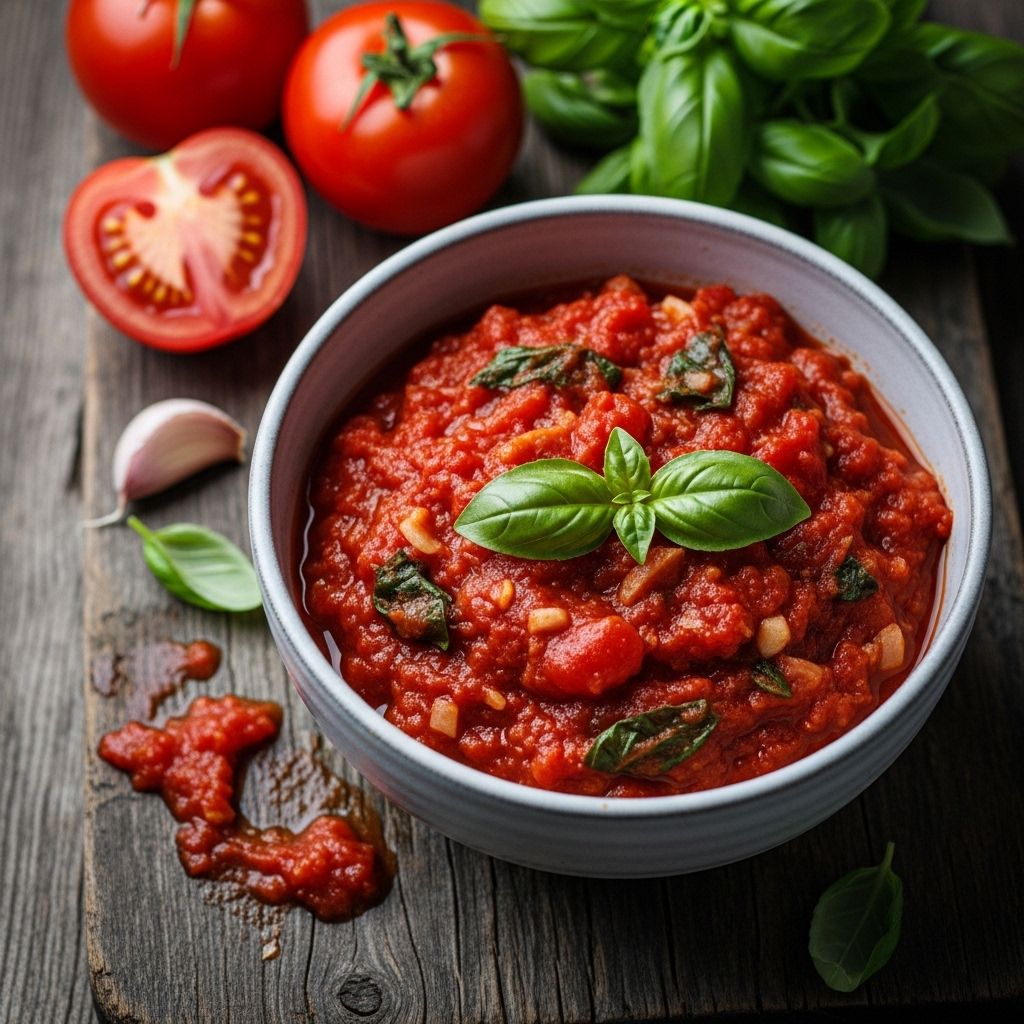Spaghetti Sauce with Fresh Tomatoes: A Homemade Classic
A slow simmer and simple seasonings unlock bold, sun-ripened flavors in every bite.

Image: HearthJunction Design Team
There’s nothing quite like the scent of a simmering pot of homemade spaghetti sauce filling your kitchen. By using fresh tomatoes alongside classic Italian herbs, garlic, and onions, you can create a sauce that’s bursting with vibrant flavors and the comforting richness that only home cooking provides. Whether for a family dinner or a weekend gathering, this easy, one-hour recipe will elevate your pasta night and help you master a beloved Italian staple.
Table of Contents
- Ingredients
- Preparation Steps
- Cooking Directions
- Tips for the Best Sauce
- Recipe Variations
- Serving Suggestions
- Storing and Freezing
- Nutrition Information
- Frequently Asked Questions (FAQs)
Ingredients
Making a delicious, fresh tomato spaghetti sauce doesn’t require complicated ingredients. Here’s what you’ll need:
- Fresh Tomatoes (Roma or plum varieties work best for their low moisture and rich flavor)
- Yellow Onion
- Garlic Cloves
- Olive Oil
- Fresh Basil
- Fresh Oregano or dried if fresh isn’t available
- Salt and Black Pepper
- Sugar (optional, to balance acidity if needed)
- Red Pepper Flakes (optional, for a hint of heat)
Feel free to adjust the herbs and seasonings according to your taste or what’s available in your pantry.
Preparation Steps
The key to a rich, flavorful sauce is in the preparation of your fresh tomatoes and aromatics. Follow these simple steps:
- Peel and Seed the Tomatoes: Score a small ‘X’ on the bottom of each tomato. Blanch them in boiling water for about 30 seconds, then transfer to an ice bath. The skins should slip off easily. Cut out the core, slice tomatoes in half, and scoop out the seeds for a smoother sauce.
- Chop the Vegetables: Dice the peeled tomatoes, onion, and mince the garlic.
- Prepare the Herbs: Finely chop fresh basil and oregano, reserving some for garnish if desired.
Cooking Directions
Once your ingredients are prepped, it’s time to bring your sauce together. This method ensures maximum flavor while keeping the process straightforward:
- Sauté Aromatics: In a large saucepan or Dutch oven, heat olive oil over medium heat. Add the finely chopped onion and cook until translucent, about 5 minutes. Stir in the minced garlic and cook for an additional minute, being careful not to burn.
- Add Tomatoes: Incorporate the chopped, peeled tomatoes into the pan. Stir to combine and bring to a gentle simmer.
- Season: Add salt, pepper, chopped basil, oregano, and a small pinch of sugar if you’d like to counterbalance acidity. For a subtle kick, sprinkle in a pinch of red pepper flakes.
- Simmer: Reduce the heat and simmer the sauce uncovered, stirring occasionally, for about 1 hour. This allows flavors to meld and the sauce to thicken naturally.
- Adjust Texture: For a chunkier sauce, leave as is. For a smoother consistency, use an immersion blender directly in the pot or transfer carefully to a countertop blender.
- Finish with Fresh Herbs: Off the heat, stir in a handful of freshly chopped basil for a pop of color and aroma.
Tips for the Best Fresh Tomato Sauce
- Use Ripe, In-Season Tomatoes: Choose the ripest tomatoes available for best flavor and sweetness. Roma tomatoes are ideal, but any garden variety can shine when in season.
- Don’t Rush the Simmer: Allowing your sauce to simmer slowly deepens the flavors and reduces excess moisture for the perfect consistency.
- Balance Acidity: If the sauce tastes too tart, a touch of sugar or a grated carrot can sweeten it naturally.
- Enhance with Wine: For extra depth, deglaze the pan with a splash of red or white wine after sautéing onions but before adding tomatoes (optional).
- Finish with Olive Oil: Stir in a final drizzle of good-quality extra virgin olive oil just before serving for added richness.
Recipe Variations
Homemade spaghetti sauce is wonderfully adaptable. Consider these popular variations:
- Chunky Vegetable Sauce: Add diced bell peppers, zucchini, or mushrooms during the sauté step.
- Meaty Bolognese: Brown ground beef, pork, or Italian sausage with your onions for a hearty, protein-rich version.
- Herb-Forward: Double up on fresh basil and parsley for a herby punch.
- Spicy Arrabbiata: Increase the red pepper flakes for a bold, spicy finish.
Serving Suggestions
Homemade fresh tomato sauce is endlessly versatile. Here are classic and creative ways to serve it:
- Over Cooked Spaghetti: The classic match — serve sauce atop your favorite variety of spaghetti or other pasta shapes.
- Layered in Lasagna: Use as a base for homemade lasagna for an added fresh flavor boost.
- Eggplant Parmesan: Spoon over breaded, baked eggplant slices for a comforting Italian-American dish.
- Pizza Sauce: Spread on homemade pizza dough for a fresher (and lighter) alternative to jarred pizza sauce.
Storing and Freezing
Batch cooking spaghetti sauce makes weeknight dinners a breeze. Here’s how to store leftovers safely:
- Refrigerator: Allow sauce to cool to room temperature, then transfer to an airtight container. Store in the refrigerator for up to 4–5 days.
- Freezer: For longer storage, freeze cooled sauce in heavy-duty freezer bags or containers for up to 3 months. Label with the date. Thaw overnight in the refrigerator before reheating.
Always reheat sauce to a simmer before serving and stir well to restore consistency.
Nutrition Information
| Nutrient | Per Serving (Approximate) |
|---|---|
| Calories | 70 |
| Total Fat | 4g |
| Sodium | 220mg |
| Carbohydrates | 9g |
| Fiber | 2g |
| Sugar | 6g |
| Protein | 2g |
*Nutrition can vary based on tomato variety and additional ingredients.
Frequently Asked Questions (FAQs)
Q: Do I need to peel the tomatoes for sauce?
A: Peeling tomatoes creates a smoother sauce texture. The quick blanching method makes peeling easy and quick.
Q: Can I make this sauce in advance?
A: Absolutely. The flavors deepen after a day in the fridge, making it great for meal prep or freezing.
Q: Is this sauce suitable for canning?
A: While many sauces can be canned, always follow safe canning procedures and consult a trusted guide to ensure acidity and preservation.
Q: What if my sauce is too watery?
A: Continue simmering uncovered to reduce the sauce. Alternatively, blend a portion to help thicken it naturally.
Q: Can I substitute dried herbs for fresh?
A: Yes. Use about one-third the amount of dried herbs in place of fresh. Add dried herbs early in cooking, fresh near the end for best flavor.
Q: How can I make the sauce richer?
A: Sauté a spoonful of tomato paste with the onions or finish with a drizzle of butter for extra richness.
Pro Tips for Perfect Sauce
- Customize the consistency with extra simmering or blending to suit your family’s preferences.
- Make it ahead and let flavors meld overnight for even better taste.
- Serve with fresh-grated Parmesan or pecorino cheese for classic Italian flair.
- Double the batch when tomatoes are in season for easy freezer meals all year round.
Conclusion
Homemade spaghetti sauce made from fresh tomatoes is a rewarding and versatile addition to any kitchen repertoire. With simple, real ingredients and a straightforward method, you can create a sauce that’s both nourishing and bursting with summertime flavor. Experiment with variations and enjoy the satisfaction that comes from cooking from scratch. Buon appetito!
References
- https://www.allrecipes.com/recipe/11966/best-marinara-sauce-yet/
- https://www.allrecipes.com/recipe/254517/spaghetti-sauce-with-fresh-tomatoes/
- https://www.allrecipes.com/gallery/tomato-sauce-with-fresh-tomatoes-recipes/
- https://www.allrecipes.com/recipe/19375/homemade-spaghetti-sauce/
- https://www.allrecipes.com/recipe/21066/spaghetti-sauce/
Read full bio of Anjali Sayee












